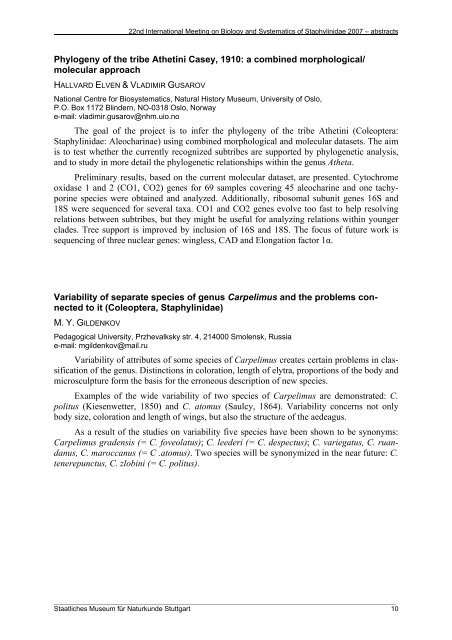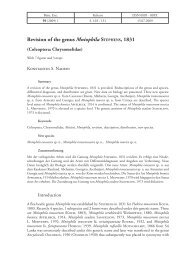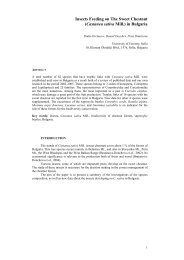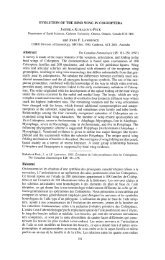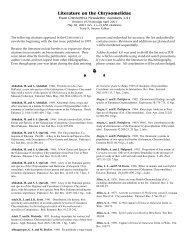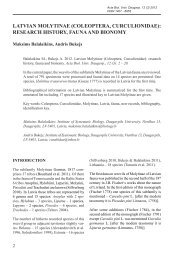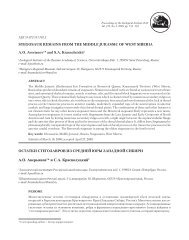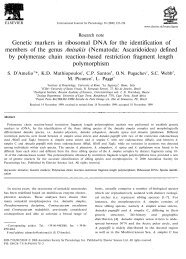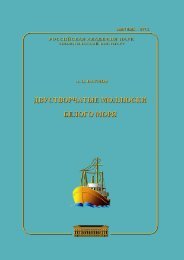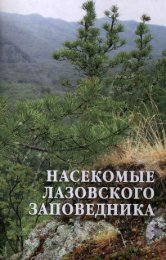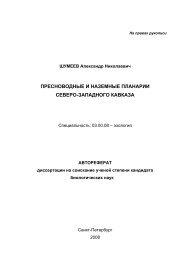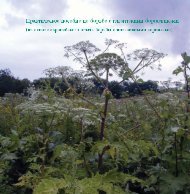International Meeting on Biology and Systematics of Staphylinidae
International Meeting on Biology and Systematics of Staphylinidae
International Meeting on Biology and Systematics of Staphylinidae
Create successful ePaper yourself
Turn your PDF publications into a flip-book with our unique Google optimized e-Paper software.
22nd <str<strong>on</strong>g>Internati<strong>on</strong>al</str<strong>on</strong>g> <str<strong>on</strong>g>Meeting</str<strong>on</strong>g> <strong>on</strong> <strong>Biology</strong> <strong>and</strong> <strong>Systematics</strong> <strong>of</strong> <strong>Staphylinidae</strong> 2007 – abstracts<br />
Phylogeny <strong>of</strong> the tribe Athetini Casey, 1910: a combined morphological/<br />
molecular approach<br />
HALLVARD ELVEN & VLADIMIR GUSAROV<br />
Nati<strong>on</strong>al Centre for Biosystematics, Natural History Museum, University <strong>of</strong> Oslo,<br />
P.O. Box 1172 Blindern, NO-0318 Oslo, Norway<br />
e-mail: vladimir.gusarov@nhm.uio.no<br />
The goal <strong>of</strong> the project is to infer the phylogeny <strong>of</strong> the tribe Athetini (Coleoptera:<br />
<strong>Staphylinidae</strong>: Aleocharinae) using combined morphological <strong>and</strong> molecular datasets. The aim<br />
is to test whether the currently recognized subtribes are supported by phylogenetic analysis,<br />
<strong>and</strong> to study in more detail the phylogenetic relati<strong>on</strong>ships within the genus Atheta.<br />
Preliminary results, based <strong>on</strong> the current molecular dataset, are presented. Cytochrome<br />
oxidase 1 <strong>and</strong> 2 (CO1, CO2) genes for 69 samples covering 45 aleocharine <strong>and</strong> <strong>on</strong>e tachyporine<br />
species were obtained <strong>and</strong> analyzed. Additi<strong>on</strong>ally, ribosomal subunit genes 16S <strong>and</strong><br />
18S were sequenced for several taxa. CO1 <strong>and</strong> CO2 genes evolve too fast to help resolving<br />
relati<strong>on</strong>s between subtribes, but they might be useful for analyzing relati<strong>on</strong>s within younger<br />
clades. Tree support is improved by inclusi<strong>on</strong> <strong>of</strong> 16S <strong>and</strong> 18S. The focus <strong>of</strong> future work is<br />
sequencing <strong>of</strong> three nuclear genes: wingless, CAD <strong>and</strong> El<strong>on</strong>gati<strong>on</strong> factor 1α.<br />
Variability <strong>of</strong> separate species <strong>of</strong> genus Carpelimus <strong>and</strong> the problems c<strong>on</strong>nected<br />
to it (Coleoptera, <strong>Staphylinidae</strong>)<br />
M. Y. GILDENKOV<br />
Pedagogical University, Przhevalksky str. 4, 214000 Smolensk, Russia<br />
e-mail: mgildenkov@mail.ru<br />
Variability <strong>of</strong> attributes <strong>of</strong> some species <strong>of</strong> Carpelimus creates certain problems in classificati<strong>on</strong><br />
<strong>of</strong> the genus. Distincti<strong>on</strong>s in colorati<strong>on</strong>, length <strong>of</strong> elytra, proporti<strong>on</strong>s <strong>of</strong> the body <strong>and</strong><br />
microsculpture form the basis for the err<strong>on</strong>eous descripti<strong>on</strong> <strong>of</strong> new species.<br />
Examples <strong>of</strong> the wide variability <strong>of</strong> two species <strong>of</strong> Carpelimus are dem<strong>on</strong>strated: C.<br />
politus (Kiesenwetter, 1850) <strong>and</strong> C. atomus (Saulcy, 1864). Variability c<strong>on</strong>cerns not <strong>on</strong>ly<br />
body size, colorati<strong>on</strong> <strong>and</strong> length <strong>of</strong> wings, but also the structure <strong>of</strong> the aedeagus.<br />
As a result <strong>of</strong> the studies <strong>on</strong> variability five species have been shown to be syn<strong>on</strong>yms:<br />
Carpelimus gradensis (= С. foveolatus); C. leederi (= C. despectus); C. variegatus, C. ru<strong>and</strong>anus,<br />
C. maroccanus (= C .atomus). Two species will be syn<strong>on</strong>ymized in the near future: C.<br />
tenerepunctus, C. zlobini (= C. politus).<br />
__________________________________________________________________________________________<br />
Staatliches Museum für Naturkunde Stuttgart 10


